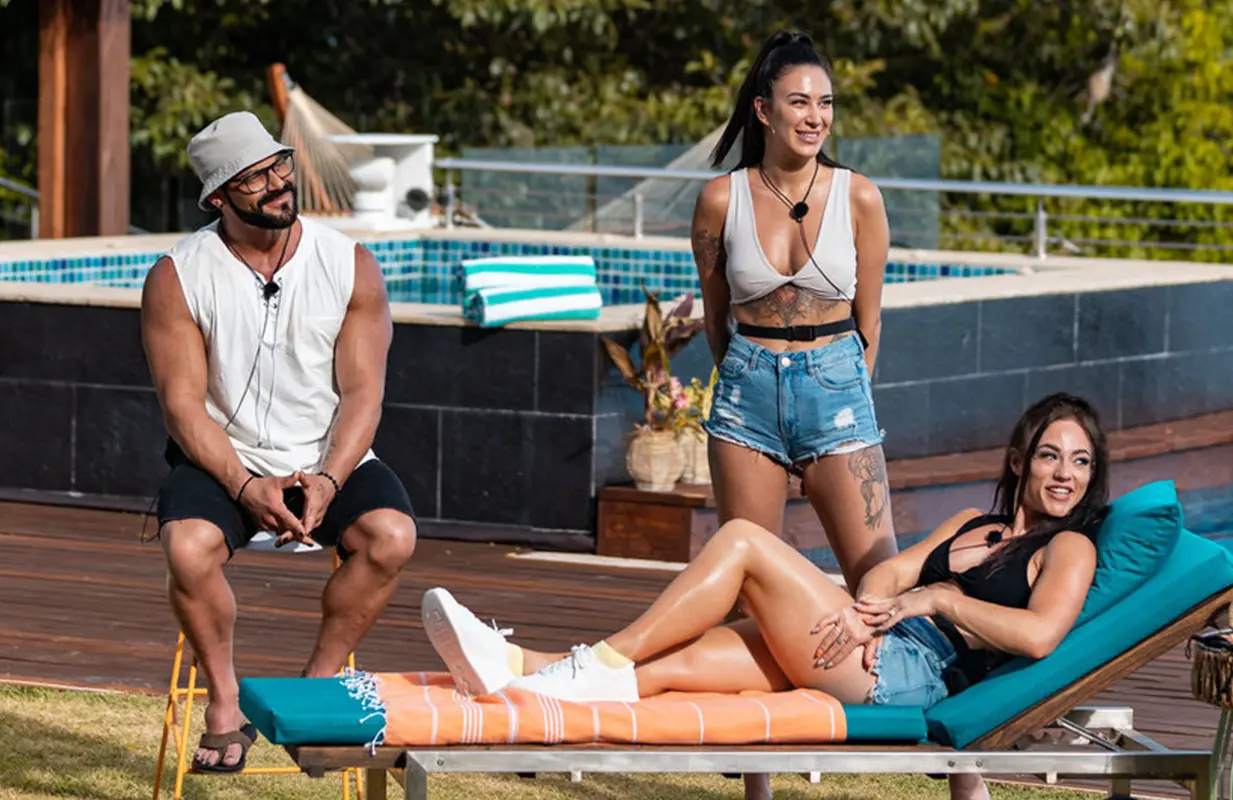Polyamorous Dating Show Couple to Throuple Can't Overcome Its Conservative Format
-
 Dylan, Becca, and Lauren in Couple to Throuple (Photo: Paul Castillero/Peacock)
Dylan, Becca, and Lauren in Couple to Throuple (Photo: Paul Castillero/Peacock)What qualifies as "good" representation? Where is the line between normalizing nontraditional lifestyles and exploiting them for commercial gain? Is it even possible to examine the progressive experiences of polyamory and nonmonogamy through a conventional format of entertainment?
These are the questions that come to mind when watching Peacock's Couple to Throuple, a new dating show that aims to destigmatize polyamory. Throughout the 10-episode season, four established couples mingle with a group of singles in hopes of finding a third partner to invite into their relationship. As they begin to "throuple up," they participate in a series of challenges designed to evaluate their compatibility; while some grow closer during this process, others look for a new connection among the available singles or question whether nonmonogamy is right for them. When their time at the show's tropical villa comes to an end, the couples must choose between three options: Go home as a throuple, leave their new partner and return to their former lives, or break up altogether.
Though Couple to Throuple will no doubt draw its fair share of rubbernecking viewers, the show approaches its subject matter without judgment. In the first few minutes of the premiere, host Scott Evans, a TV personality best known for his work on Access Hollywood, establishes his bona fides by telling the couples that he's had his "own experiences with ethical nonmonogamy," and he encourages the cast to take advantage of this opportunity to explore different possibilities. "This is a place where anything can happen," Scott says, explaining that the villa is "a safe place" for them to determine what they truly want and whether their desires align with those of their partner (or partners).
Peacock's dating show also boasts a diverse cast, both in terms of identity and experience with polyamory. Some participants, like Dylan and Lauren (the only married couple in the villa), have opened up their relationships in the past, while others, including Ashmal and Rehman and Brittne and Sean, are new to nonmonogamy and hope it will add a different dimension to their bond. The distinct goals and sexual fluidity among the group — many cast members are bisexual or pansexual, broadening the possible array of connections — reflect the diversity and intersectionality of the poly community, something that's been lost in the recent string of articles about white, wealthy polycules.
But despite the show's pure intentions, it often feels like Couple to Throuple is attempting to fit a square, polyamorous peg in a round, The Bachelor-shaped hole. In addition to Evans, expert Shamyra Howard is on hand to guide the couples through their journey, but the "relationship sessions" she leads are designed to incite made-for-TV conflict, not engender trust among the throuples.
Howard's exercise in the second episode, "Boundaries," is particularly problematic. In order to "test [their] threshold" for watching their partner get intimate with someone else, one person sits by as the other is straddled, licked, sucked, and kissed by their newly chosen third. Though anyone can stop the proceedings by saying a "safe word" when they become uncomfortable, the challenge is still incredibly manipulative, as it's intended to reopen old wounds — Corey explains that her boyfriend Wilder has "crossed a boundary" with someone in the past — and stir up jealousies, as becomes the case with Rehman, who shuts down after watching Ashmal make out with new partner Jonathan.
Making matters worse, Couple to Throuple's regimented structure runs counter to its progressive themes and the open-mindedness of its cast. During the first Matching Ceremony, the couples must select a single to invite into their room, and with a finite number of people to choose from, a sense of competition takes hold as the couples fight for time with their new love interests. The only agency the singles, who don't stay in the villa unless they're chosen as a third, are given is the ability to say no to a match; otherwise, producers are invested in their experience only as it relates to that of the couples.
And when that experience is negative, as we see with two of the throuples (Dylan, Lauren, and new partner Becca, and Brittne, Sean, and Sanu), they must stick it out until the next Stay-or-Swap Ceremony. By the third episode, "Jealousy," both Becca and Sanu have opted to stay in their own rooms, but the fact that they're forced to remain in the villa for an unidentified number of days contributes to the sense that the concept of "consent" applies only to the couples, not the third partner they're bringing into their relationships.
While there are some positives to be found in Couple to Throuple — including its concerted effort to reduce the shame around sexual pleasure and female desire — producers' adherence to the rules of dating competition shows trumps all. TV can and should celebrate nontraditional relationships, but three episodes in, doing so in such a standardized, conservative format is looking like a failed experiment.
New episodes of Couple to Throuple drop Thursdays on Peacock.
Claire Spellberg Lustig is the Senior Editor at Primetimer and a scholar of The View. Follow her on Twitter at @c_spellberg.
TOPICS: Couple to Throuple, Peacock, The Bachelor